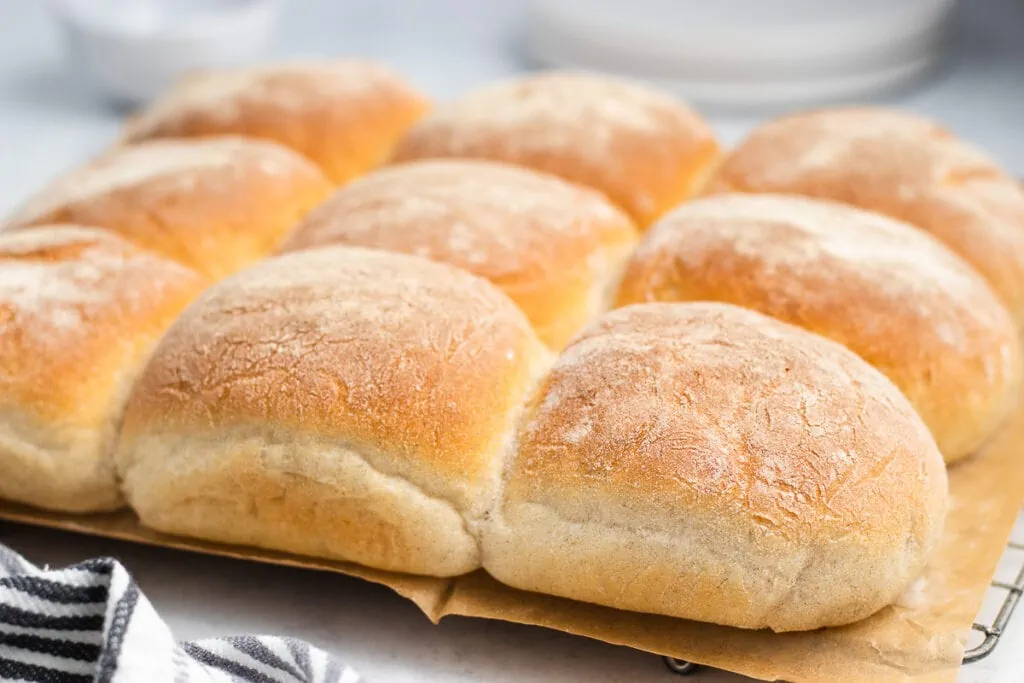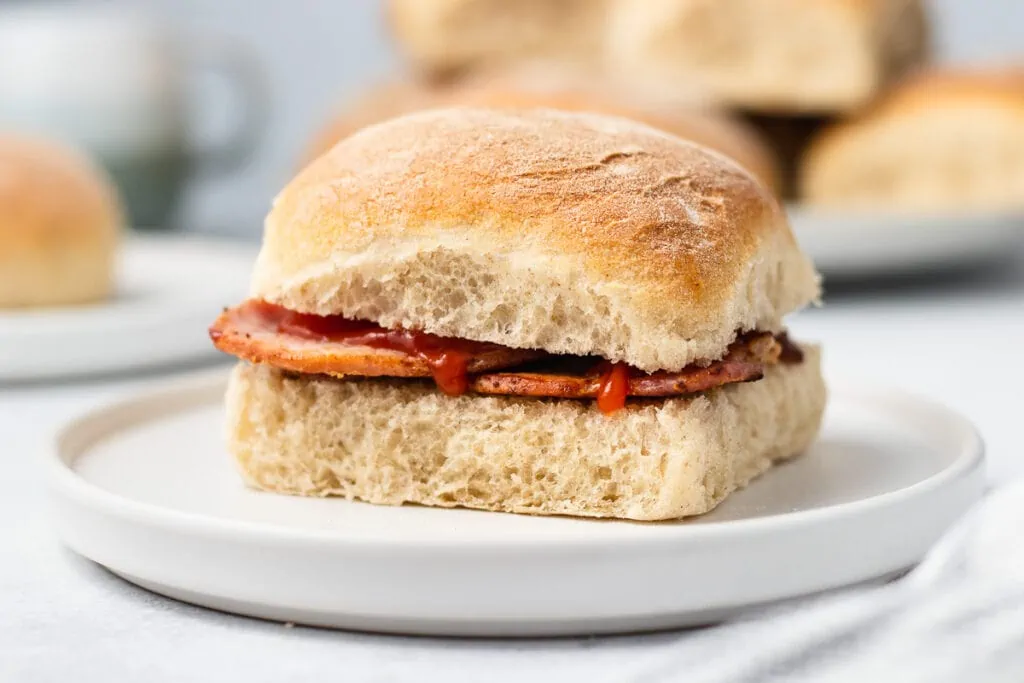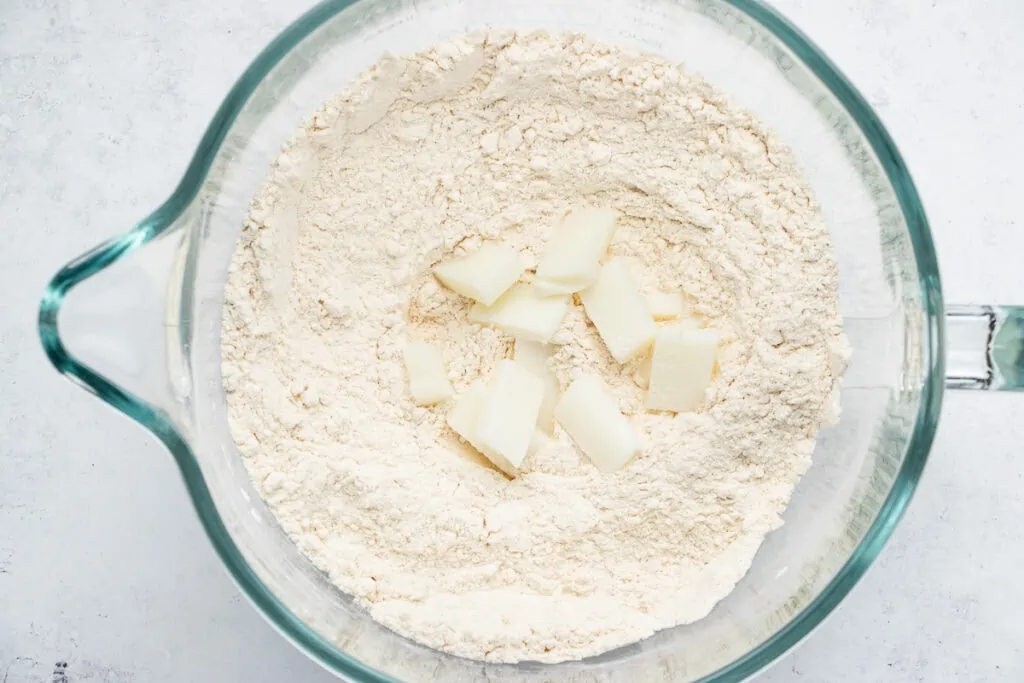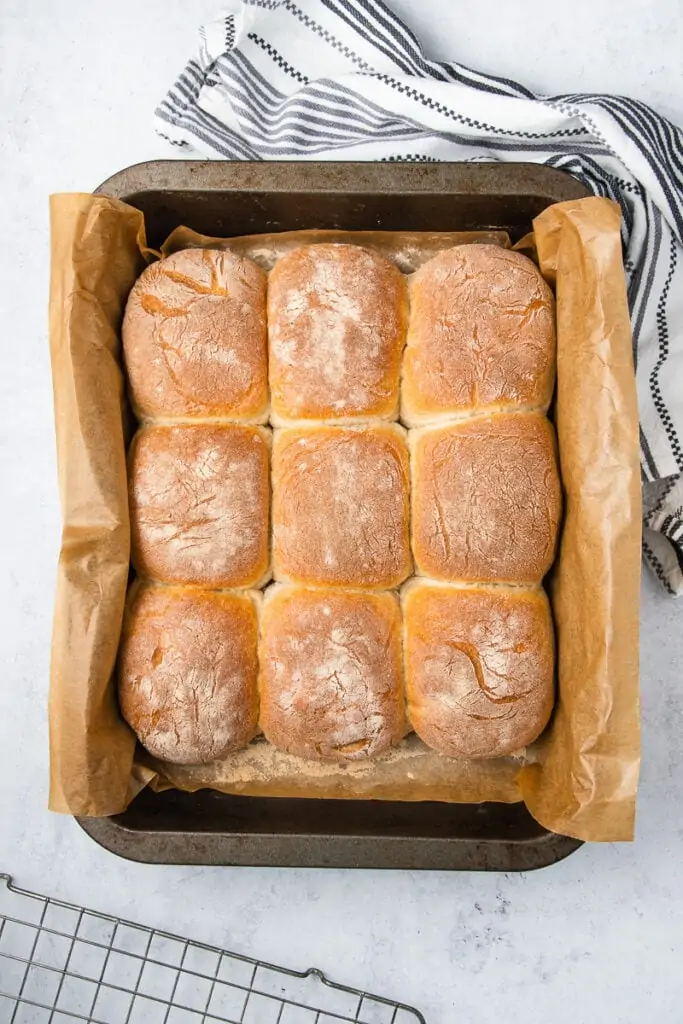A tasty and traditional Scottish Morning Rolls recipe has been requested in our Facebook group more times than any other recipe, yet we are only now sharing it. Why do you think that is?
Well, it’s because a Scottish Morning Roll has a unique taste and is a recipe held so dearly in the hearts of so many we had to be absolutely sure of before we would even consider putting it out into the big wide world!

If it’s too bap-like, a morning roll will be thrown away in disgust. If it is too crunchy, it will be left alone on a plate, its contents eaten separately!
A Scottish morning roll recipe has to produce rolls that look, taste and feel like they have just come from the bakers and are the perfect shape and size to deal with even the largest slice of Lorne sausage.
Pin for later!

Our Stovies recipe was the only other recipe we’ve been this cautious about. Despite offering as many versions as possible, that recipe still starts arguments on social media whenever we post it.
However, lovers of Scottish food are a passionate bunch, and there are just certain Scottish foods you don’t mess with. The morning roll is on the top of that list.
Why did we decide to do a Morning Rolls recipe at all?
The simple answer is because morning rolls are delicious! It’s hard to pinpoint precisely what makes them quite so unique, but they are just the right sort of everything you could ever want in a fresh bread roll.
Fluffy yet tough, delicate yet solid, savoury yet subtly sweet. Fresh from the bakers these rolls can be topped by no other, and we couldn’t resist recreating them for you.
And, we’re happy to say we think we’ve cracked it!
What is a Scottish Morning Roll?
Let us explain for those of you unsure about the sort of rolls we’re talking about. A Scottish Morning roll is a freshly baked, often well fired white bread roll. They have a light crisp on the outside but are deliciously airy on the inside, making them perfect for having heavier meaty fillings such as bacon, sausage or even a Scotch Pie!
Some are so well fired they are almost black on the outside, giving them a burnt look, but they taste divine. Our recipe is a less fired, more golden variety but equally as tasty!
These rolls are found across Scotland in every bakery, corner shop, supermarket and even the odd garage. Though not as famous as the likes of Haggis or Tablet, the Morning Roll is known by every single Scot and loved by most.


Why are Morning Rolls called Morning Rolls?
This one seems to answer itself, but we still had to check with numerous friends in case we were missing a trick! The Morning roll is called a morning roll due to them being best straight from the baker freshly made in the morning.
They were traditionally served with or as breakfast or made into a packed lunch for the workers of school children of the family. They are also known as Glasgow rolls, but these tend to be the more oven-fired blackened variety as we understand it.
As bakers grew in size and were able to mass-produce the morning roll, other names stuck, such as Mortons and McMillan’s rolls.
So there you have it, the delicious morning roll is called that because they’re best eaten in the morning. Simple really.

Things you’ll need to make our Morning Rolls recipe
- Large bowl
- Whisk
- Wooden Spoon
- Electric Mixer with dough hook attachment (or you can knead by hand)
- Cling film or tea towel for proofing
- Baking paper
Ingredients for our Morning Rolls recipe
Ingredients:
- 650g strong white flour (5 cups)
- 1 ½ tsp salt
- 400ml lukewarm water (between 37-43 degrees Celsius – make sure the water isn’t too hot or it will kill the yeast) (1 2/3 cups)
- 1 ½ tsp caster sugar
- 7g dried instant yeast
- 40g lard (cold, chopped) (3 tbsp)
- Rice flour to dust

How to make Morning Rolls – Step by step method
Servings: 9-12 rolls
Prep time: 40 minutes
Proofing time: 2-3 hours
Baking time: 15 minutes
Add the sugar to the warm water and stir until dissolved.
Add the yeast and stir again to combine. Set aside.
In the bowl of an electric stand mixer, whisk together the flour and salt.
Rub the lard into the flour to make breadcrumbs, like you would with scones.
Make a well in the centre of the flour mixture and pour in the yeast mixture.
Stir with a wooden spoon until it starts to come together into a dough.



Using a dough hook attachment on your mixer, mix the dough on a medium speed for 10 minutes. You can also knead by hand if preferred but make sure to do so for the full 10 minutes to get it nice and elastic.

Sprinkle your work surface with a little rice flour. Turn the dough out onto the surface and shape it into a ball with your hands.
Lightly grease a large mixing bowl with a little oil and place the dough in it. Cover loosely with cling film or a tea towel and leave in a warm place (around 25 degrees C is ideal) to proof for 1 to 1 ½ hours, or until roughly doubled in size.



Turn out the dough onto your floured work surface and squash it down flat with your hands to knock out the gas. Then roughly roll it up into a sausage shape to make it easier to cut into pieces.

For perfectly even rolls, you can weigh the dough and divide it by the number of rolls you’d like to make. The mixture will make 9-12 depending on the size of the rolls and your baking tray. Cut the dough into your sections and shape these into balls by rolling them with your hands.
Dust the top of each roll with a little rice flour.


Squash the rolls down into slightly flattened disks using your hands or a rolling pin. They will rise back up again during the second proof.
Line a large oven tray with baking paper. Place the rolls inside. Make sure they are touching to get that pull-apart effect.


Cover the tray loosely with cling film or a tea towel and leave in a warm place to proof for another 1 to 1 ½ hours or until nicely plump and risen. About 15 minutes before your proofing time is up, preheat the oven to 230C.
Bake the rolls for 15 minutes or until golden all over the top.

Use the baking paper to lift the rolls out onto a cooling rack. Allow them to cool for 15 minutes or so before pulling them apart.

Variations
Normally, we give some variations on our recipes, different ingredients or ways to create a similar dish. However, we don’t have any for our Morning rolls recipe; stick to the recipe and enjoy your rolls.
Some things don’t need any amendments!
Well Fired Rolls
However, there is just one thing you could try if you’re up for it.
If you’re ever in Scotland, you might notice rolls for sale that look a little, well, burnt on top. This isn’t a mistake! These are actually called “well fired” rolls. You can make your morning rolls well fired by making sure they’re high in the oven and cooking for around 5 minutes longer.
Fillings for Morning Rolls
Morning rolls are most often eaten as a breakfast food with one or more of the following:
- Bacon
- Haggis or Veggie Haggis
- Link Sausages or Lorne Sausage (also called Square Sausage)
- Fried Egg
- Tattie Scone
- Black Pudding
These are then often accompanied by either brown or red sauce, also known as HP or ketchup.
One other morning roll filling you might find in some parts of Scotland is a Scotch pie. Yes, a whole scotch pie!

More Recipes for Scotland’s Most Popular Foods
- Mince and Tatties
- Traditional Scottish Tablet Recipe
- Homemade Lorne Sausage
- Easy and Authentic Scotch Pie Recipe
Scottish Morning Rolls Recipe

Scottish Morning Rolls are unique to Scotland.
While there are similar bread rolls in other places we've never quite found the perfect texture and combination of a light fluffy interior with a slightly chewy crust that can hold delicious ingredients inside like haggis, square sausage, tattie scones, and even a Scotch Pie!
This recipe has taken some time for us to do, because we knew it had to be PERFECT. Enjoy!
Ingredients
- 650g strong white flour (5 cups)
- 1 ½ tsp salt
- 400ml lukewarm water (between 37-43 degrees Celsius – make sure the water isn’t too hot or it will kill the yeast) (1 2/3 cups)
- 1 ½ tsp caster sugar
- 7g dried instant yeast
- 40g lard (cold, chopped) (3 tbsp)
- Rice flour to dust
Instructions
- Add the sugar to the warm water and stir until dissolved.
- Add the yeast and stir again to combine. Set aside.
- In the bowl of an electric stand mixer, whisk together the flour and salt.
- Rub the lard into the flour mixture.
- Make a well in the centre of the flour mixture and pour in the yeast mixture.
- Stir with a wooden spoon until it starts to come together into a dough.
- Using a dough hook attachment on your mixer, mix the dough on a medium speed for 10 minutes. You can also knead by hand if preferred but make sure to do so for the full 10 minutes to get it nice and elastic.
- Sprinkle your work surface with a little rice flour. Turn the dough out onto the surface and shape into a ball with your hands.
- Lightly grease a large mixing bowl with a little oil and place in the dough. Cover loosely with cling film or a tea towel and leave in a warm place (around 25 degrees C is ideal) to proof for 1 to 1 ½ hours, or until roughly doubled in size.
- Turn out the dough onto your floured work surface and squash it down flat with your hands to knock out the gas. Then roughly roll it up into a sausage shape to make it easier to cut into pieces.
- For perfectly even rolls, you can weigh the dough and divide it by the number of rolls you’d like to make. The mixture will make 9-12 depending on the size of the rolls and your baking tray. Cut the dough into your sections and shape these into balls by rolling them with your hands.
- Dust the top of each roll with a little rice flour.
- Using your hands or a rolling pin, squash the rolls down into slightly flattened disks. They will rise back up again during the second proof.
- Line a large oven tray with baking paper. Place the rolls inside. Make sure they are touching to get that pull-apart effect.
- Cover the tray loosely with cling film or a tea towel and leave in a warm place to proof for another 1 to 1 ½ hours or until nicely plump and risen. About 15 minutes before your proofing time is up, preheat the oven to 230C.
- Bake the rolls for 15 minutes or until golden all over the top.
- Use the baking paper to lift the rolls out onto a cooling rack. Allow them to cool for 15 minutes or so before pulling apart.
Notes
Try these with our veggie haggis or square sausage recipes!
Nutrition Information:
Yield:
12Serving Size:
1Amount Per Serving: Calories: 279Total Fat: 4gSaturated Fat: 1gTrans Fat: 0gUnsaturated Fat: 2gCholesterol: 3mgSodium: 293mgCarbohydrates: 53gFiber: 2gSugar: 1gProtein: 7g
These values are an estimate only.
Do let us know in the comments or in our Facebook group if you make these. We’d love to hear what you think of our Morning Rolls recipe!
Enjoy Phil & Sonja

I’ve just made them. They are delicious and not too hard to make.
We’re so pleased you like them!
Really good rolls! I had no access to rice flour, so used tapioca flour. Don’t ask me why. Still, this turned out good. Rolls accompanied almost all suppers when I was growing up, and this is now my go-to roll recipe. Well done! Really enjoy your narrative of the processes. Laughter is a wonderful thing.
i take it the lard gets added at the same time as the liquid yeast mix?
No, rub the lard into the flour to make breadcrumbs after you’ve added the salt 🙂
What if you do not have rice flour does it make a difference ?
It wouldn’t too much, it’s just to dust the tops of the rolls.
They are amazing
Is there an alternative to lard? Always loved my rolls when I was younger… now live 400 miles away so looking to recreate but with a veggie in the house lard isn’t an option. Would butter work or vegetable suet?
Hi Adele, great question. Butter is often the easiest replacement for lard when needs must. It would seem a 1:1 ratio or even a 1:1.25 (Lard: Butter) is the general rule of thumb to get as close to the original taste as possible.
Sadly though, it will never be quite right, and you may be able to taste the difference. That doesn’t mean you won’t make awesome bread, just maybe not quite the traditional Morning Roll.
Hi John,
Sorry John, we haven’t got a bread machine to try this for you. We done’t see why it wouldn’t but would suggest there’s probably a reason bakers do it by hand. Good luck experimenting!
I’m curious what size of baking tray was used for making 9 rolls?
16inch worked well for us, but you can adjust the size of the dough for the size you have.
great rolls just like i remember them[ scottish living in england ] just one question can you do 2nd proofing in the fridge and if so would you shape to size prior to putting in fridge or after the 2nd proofing.
cheers
Hi! It is possible to do this. You would continue the recipe as normal, shaping before the second proof, and then place in the fridge. This slows down the proofing process so you could leave them in there overnight, or for a longer period than at room temperature. We haven’t tried it ourselves so can’t give you an exact time! If you feel like they’ve over-proofed then you’d need to punch the dough back down and shape and proof again to try and rescue it. There is also some debate about whether you should bring it back up to room temperature before baking. Without testing we wouldn’t know so please do let us know how you get on! We’ll have to try ourselves sometime.
I found the amount of lard in the recipe to be insufficient to achieve the desired breadcrumb effect, so I’ve made these rolls again using 120 grams of lard( doing the 1st proof now as I write). I will let you know how they turn out.
Do let us know how it turned out!
Great recipe made them today just as good as the ones my mate in Glasgow gets for breakfast when I visit from Newcastle well done
Thanks so much for letting us know! Glad you enjoyed them!
Hello,
Living in rural Canada. I’m definately going to try this. There is nothing better than a good Scottish Morning roll.
I remember visiting Scotland as a kid in the 70’s, and my Grandmother used to get these coconut topped elongated buns, which had nothing in the centre, from a local bakery in Dundee. Absolutely fantastico… If anyone knows how to make those, please pass it on!
Thx …
We asked our facebook group Thomas, fingers crossed for you!
Hi Thomas,
Here’s the answers for you https://www.facebook.com/groups/ScottishScranStories/posts/1663721380769477/
They are just a plain sweet nun shaped into fingers and then iced. Scran…do we have a recipe for plain buns like those used in cream cookies? I am sure it’s the same recipe.
Hello, we don’t have a recipe but we certainly remember just a plain bread bun with icing on it as a treat at school. You could easily use our morning roll recipe for this, just shaping them slightly differently.
What a time school was in the 80s bread and icing as a treat! 😂
Hi,
I made these and they worked pretty well, probably the closest I’ve had to real morning rolls since moving to the US 14 years ago. But they did end up a little heavy, and less airy than the real thing. Next time I’m going to make 12 instead of the 9 I did this time, which may help. Any other thoughts on how to get them airier?
Thanks!
Hi! Thanks for letting us know! It may come down to the type of flour, or to how long they are proved for. You could try a slightly longer proving time and see if that helps. The other options is trying flour with different levels of protein to see what works best. The strong bread flour we use tends to have 12-14%, depending on the brand, so you could see what yours has and try one with more/less to see what works best as well.
Is it 1 tsp of salt or 1and a half tsp of salt .
Hi Alan, it’s 1.5 tsp of salt
Hi there from Canada. Strong flour we have but I question one ingredient. Instant yeast? With the proofing time used I would be more inclined to use traditional yeast. Any thoughts?
Honestly not really, it took us a long time to get the right taste for this recipe so we haven’t played around with it too much! Do let us know how they turn out though.
Made them a couple of weeks ago. Worked out great so trying a second batch right now
So pleased they worked. This recipe was one of the most nerve-racking, had to get it just right.
Absolutely delicious! I can’t believe how easy it was to make these. Now I have to make the square sliced sausage to put in them.
Another thing I still miss after 40 years in England is plain bread with a nice dark, chewy crust. So what about a recipe for a plain loaf?
We’ll see what we can do!
I live in England, and I can get a plain loaf in Marks & Spencer food hall.
Thanks for letting us know. 🙂
Re: Morning rolls, they were only available to buy first thing in the morning. My first ever paid job was delivering these out of the back of a van to the front doors of homes all round round Falkirk. Started at 5.30 am, then home with 2 warm rolls for breakfast at 8. then off on my bike 2 miles to school. This as 6 days a week, in all weathers and the pay was ten shillings a week. I was 11 years old and this was 1961. The rolls were crispy crusty on the outside snd fluffy inside. Delicious with bacon or a fried egg
or more often cheese or jam in my family.
Can you freeze rolls, before baking or after.
We haven’t personally tried it but think it would be possible, you’d just need to figure out the best time. The easiest option is probably to freeze as soon as they’ve cooled after baking, and then you can allow them to come back to room temperature on the benchtop before eating. We would only freeze them for up to a month or so. Make sure they’re wrapped securely to avoid freezer burn. Freezing before baking might be a bit of trial and error but we would suggest doing it after the first proof.
North Carolina here. I’ve been trying to make morning rolls from many recipes for my Scottish bride of 52 years but keep striking out with the well fired bit. Thanks for the solution about putting them high in the oven, will be trying that today. Also i see you say 7g of instant yeast. I’ve been using the packaged yeast and noted that a package is 21g so a bit over kill maybe?
A huge thank you for this recipe. I run a guest house on the Isle of Lewis, serving my own bread amongst other home made goodies (jams, marmalades, ketchups, crowdie, butter, etc) but I never found a truly great recipe for morning rolls – till now! If guests have to catch an early ferry, they have to leave the house at 0530, missing breakfast. I always get up and make bacon rolls to go for them instead. This week, after following your recipe, I was able to offer them these morning rolls fresh from the oven, and they went down a storm, filled with smoked bacon and home made sweet chilli ketchup
We’re very pleased to hear they’re such a hit and we’ve been of use! What a stunning part of the world you live in, we’re very jealous. Thank you for letting us know about the recipe, you’ve made our day.
I make rolls about every third week. To get them well fired Glasgow style, I put them under the broiler for a couple of minutes. This prevents the rolls from getting too hard with that extra baking time in the oven. Don’t leave them as this broiling procedure just takes a COUPLE of minutes.
I’ve just made these rolls, pleased with the result though they are a little heavy and have a smell resembling scones.
I think the heaviness maybe due to the flour I used one with 10% protein, so will try again with a higher protein – the smell – any ideas?
That’s an odd smell to have, again it may be down to the flour you used, do let us know if your next batch turns out better.
We do not have lard here in Egypt can i use ghee or vegetable margarine or butter. Also can I mix it in the breadmaker on the dough setting. Thanks a lot
You can do all of those things but we can’t promise they’ll taste like Morning Rolls, we’ve only found this way of doing it that recreates that bakery taste.
I was in Scotland in 2022, I attended the Highland Games around Loch Ness. While there I got a chicken salad sandwich. The bread was incredible, I have been looking for that recipe and even made a few but it just isn’t right. Would you happen to know what kind of bread would be used for a chicken salad sandwich? I know this is a stretch but I would love to have that.
Sorry, we genuinely have no idea as it would depend on the people who made it! There’s no standard bread used.
Made these a few times now – excellent results, far beyond my expectations! We have no lard here in Italy, but I subbed butter once using the ratio suggested above, and once like for like – the second batch was marginally better, maybe because the butter here is a little different. The rolls freeze well wrapped individually in cling film, then foil. I’ve lived in Glasgow and Lewis, and these rolls would be right at home in both places – thanks loads!
This is great to hear, thanks!
The rolls looked good but were a little bit heavy more like scones inside
Sounds like they needed to prove for a little longer Keith.